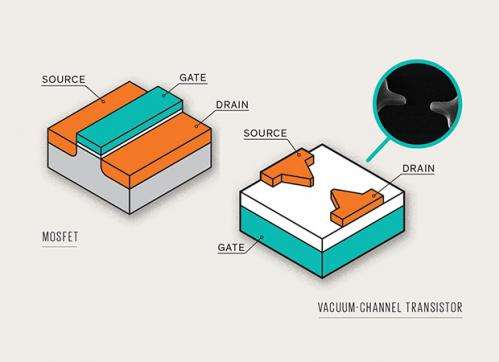June 25, 2014 weblog
Scientists explore mash-up of vacuum tube and MOSFET

Thumb-size vacuum tubes that amplified signals in radio and television sets in the first half of the 20th century might seem nothing like the metal-oxide semiconductor field-effect transistors (MOSFETs) that dazzle us with their capabilities in today's digital electronics, say two scientists, but it might be time for fresh thinking about vacuum tubes and even some mashing-up for surprising results. Jin-Woo Han, research scientist, and Meyya Meyyappan, chief scientist for exploration technology, at NASA Ames Research Center in California, wrote an article that appeared in IEEE Spectrum on Monday, which details their explorations of a vacuum channel transistor. Their article indicates "vacuum channel transistor" is a phrase to watch in the context of what's next in transistor technology. The what's-next conversation is certainly one that continues.
"After four decades of shrinking transistor dimensions, the oxide layer that insulates the gate electrode of a typical MOSFET is now only a few nanometers thick, and just a few tens of nanometers separate its source and drain. Conventional transistors really can't get much smaller. Still, the quest for faster and more energy-efficient chips continues. What will the next transistor technology be? Nanowires, carbon nanotubes, and graphene are all being developed intensively. Perhaps one of these approaches will revamp the electronics industry. Or maybe they'll all fizzle." Instead, they said, it might come as a surprise to learn that "some very modest changes to the fabrication techniques now used to build integrated circuits could yet breathe vacuum electronics back to life."
The two wrote that "At the NASA Ames Research Center, we've been working for the past few years to develop vacuum-channel transistors. Our research is still at an early stage, but the prototypes we've constructed show that this novel device holds extraordinary promise."
The IEEE Spectrum article headlines described the work as a "curious mash-up of vacuum tube and MOSFET," which could one day replace traditional silicon.
They wrote that "We've been working to develop yet another candidate to replace the MOSFET, one that researchers have been dabbling with off and on for many years: the vacuum-channel transistor." They reported results of their work so far. "Our very first effort to fashion a prototype produced a device that could operate at 460 gigahertz—roughly 10 times as fast as the best silicon transistor can manage. This makes the vacuum-channel transistor very promising for operating in what is sometimes known as the terahertz gap, the portion of the electromagnetic spectrum above microwaves and below infrared." This is noteworthy. They said "terahertz waves are difficult to take advantage of because conventional semiconductors aren't capable of generating or detecting this radiation. Vacuum transistors could—pardon the expression—fill that void." Promising applications for terahertz equipment include directional high-speed communications and hazardous-materials sensing.
Vacuum tubes have not exactly been considered as cutting edge. The authors as a historical note said that in the United States vacuum tubes had given way to smaller and less power-hungry solid-state devices; By the mid-1970s, "the only vacuum tubes you could find in Western electronics were hidden away in certain kinds of specialized equipment—not counting the ubiquitous picture tubes of television sets." Even those are gone, they added, "and outside of a few niches, vacuum tubes are an extinct technology."
When considered purely as a medium for transporting charge, they said, vacuum wins over semiconductors. "Electrons propagate freely through the nothingness of a vacuum, whereas they suffer from collisions with the atoms in a solid (a process called crystal-lattice scattering). What's more, a vacuum isn't prone to the kind of radiation damage that plagues semiconductors, and it produces less noise and distortion than solid-state materials."
But now, the two scientists said the candidate they have been working to develop to replace the MOSFET, one that researchers have been dabbling with off and on for a while, is this vacuum-channel transistor, a bridge between traditional vacuum tube technology and modern semiconductor-fabrication techniques. "This curious hybrid combines the best aspects of vacuum tubes and transistors and can be made as small and as cheap as any solid-state device. Indeed, making them small is what eliminates the well-known drawbacks of vacuum tubes."
While they see a great deal of work that remains to be done before one can envision commercial products emerging, when they do, they said, "this new generation of vacuum electronics will surely boast some surprising capabilities."
More information: spectrum.ieee.org/semiconducto … vice-made-of-nothing
© 2014 Tech Xplore


















